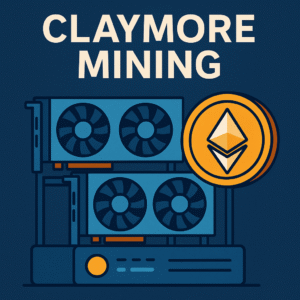Introduction
Claymore mining refers to the use of the Claymore Dual Miner, a once-popular cryptocurrency mining software designed primarily for Ethereum and other Ethash-based coins. Known for its efficiency and dual mining feature, Claymore allowed users to mine two cryptocurrencies at the same time without significant drops in performance. Although no longer actively updated, Claymore was widely adopted during Ethereum’s proof-of-work era and played a major role in shaping the mining community.
Understanding how Claymore worked helps provide insight into earlier mining tools, GPU-based mining setups, and the evolution of mining software over time.
What Is Claymore Dual Miner?
Claymore Dual Miner was a command-line mining software developed to support GPU mining for Ethereum and compatible coins using the Ethash algorithm. Its standout feature was the ability to mine two coins simultaneously – typically Ethereum and another coin like Decred, Siacoin, or LBRY – using the same graphics card.
Unlike mining programs that focused on a single cryptocurrency, Claymore aimed to make full use of a GPU’s resources. While Ethereum would use the GPU’s core and memory, the second coin typically used spare computational capacity. This way, miners could earn more without significantly impacting performance.
Claymore became popular not only for its dual mining capability but also for its stability, performance optimizations, and wide compatibility with AMD and NVIDIA GPUs.
How Claymore Mining Software Worked
Claymore was a Windows and Linux-based application that required configuration through batch files. Users would download the software, create a “start.bat” file, and input parameters like their wallet address, mining pool, and preferred algorithm.
One of Claymore’s key strengths was its detailed output. It displayed real-time statistics such as hashrates, accepted shares, temperatures, fan speeds, and GPU load. This level of monitoring gave miners control and confidence in their rigs.
Claymore also supported remote management through HTTP, allowing miners to control and check rigs across a network. This was especially useful for users managing multiple mining machines, also known as “farms.”
Dual Mining Explained
The core appeal of Claymore was its ability to mine two coins at once. This dual mining setup took advantage of unused resources in the GPU when mining Ethereum. For example, after Ethereum used the core functions and memory, some processing power remained. Claymore would redirect that spare capacity toward mining a second coin with low resource demand.
This meant extra profit with almost no extra electricity cost. The performance loss for Ethereum mining was typically around 2% to 5%, while the secondary coin provided an additional income stream.
Users could fine-tune performance settings, adjust fan speeds, and manage power usage to optimize for specific hardware and environmental conditions.
Compatibility and Supported Hardware
Claymore was compatible with both AMD and NVIDIA graphics cards, making it accessible to a wide range of users. It supported major GPU architectures like AMD’s Polaris (RX 400/500 series) and NVIDIA’s Pascal (GTX 10xx series), among others.
The software worked well on mining rigs running Windows 7/10 or Linux, although most users preferred Windows due to its broader GPU driver support.
To maximize performance, Claymore also allowed the use of different mining intensities per card, which was especially helpful for mixed GPU rigs. It was not uncommon for users to configure each card individually to reach a balance between hashrate and stability.
Claymore and the Ethereum Mining Community
During Ethereum’s early proof-of-work days, Claymore was a staple in the mining community. It helped hobbyists and semi-professional miners alike get the most out of their hardware. Online forums, mining communities, and YouTube channels featured tutorials, benchmarks, and configuration guides for Claymore.
Its flexibility and ability to boost mining profits without added costs gave it an edge over other software at the time. Users could also switch between pools easily or automate restarts after errors, which reduced downtime and increased efficiency.
Claymore’s transparent dev fee (usually around 1%) also made it more acceptable among users, compared to closed-source or hidden-fee alternatives.
Why Claymore Is No Longer Updated
Claymore’s development came to a halt around late 2020. The exact reasons remain unclear, as the developer maintained a low profile and communicated sparingly. However, a few factors likely contributed:
-
The rise of competing mining software like PhoenixMiner and T-Rex, which offered improved features and more frequent updates.
-
Increasing complexity in GPU drivers and OS updates made ongoing support more difficult.
-
The impending Ethereum transition from proof-of-work to proof-of-stake (completed in 2022) reduced long-term demand for Ethash miners.
As a result, many users began switching to newer miners that offered better compatibility and support for newer GPUs and algorithms.
Alternatives to Claymore
Today, several mining software solutions have stepped in to fill the gap left by Claymore. These include:
-
PhoenixMiner: Similar in layout and performance to Claymore, often viewed as its spiritual successor.
-
T-Rex Miner: Popular among NVIDIA users, supports multiple algorithms and coins.
-
NBMiner: Supports both AMD and NVIDIA, with regular updates and competitive performance.
-
TeamRedMiner: Optimized specifically for AMD cards, often used for Ethereum Classic mining.
These alternatives offer better performance on newer GPUs, lower dev fees in some cases, and more active development.
Security and Risks
Because Claymore is no longer maintained, using it today comes with risks. Older software may not be compatible with modern drivers or operating systems. There’s also a higher chance of security vulnerabilities, such as potential backdoors or bugs that can be exploited.
Since the software is closed-source, users cannot verify its code. Many community members recommend avoiding outdated mining software for these reasons, especially when handling valuable hardware and wallet information.
When downloading Claymore or any legacy mining tool, it’s essential to verify sources and avoid modified versions that might contain malware.
Legacy and Impact
Despite its decline, Claymore left a lasting mark on the mining landscape. It helped many users get started with GPU mining, offered an accessible way to boost profitability, and influenced the design of newer mining programs.
Even years later, mining guides and forums still reference Claymore settings, logs, and performance data. It remains part of the collective memory of Ethereum’s proof-of-work era.
Claymore also highlighted the importance of efficient GPU usage and inspired more miners to explore custom setups and hardware optimization.
Conclusion
Claymore mining refers to an influential era in cryptocurrency mining when the Claymore Dual Miner software helped users maximize their GPU performance by mining two coins at once. Though development has stopped and the software is outdated, its impact on the mining community is still felt today.
Claymore played a key role in popularizing dual mining and gave miners tools to increase earnings with relatively little technical effort. While newer tools have taken its place, understanding Claymore’s role helps explain the evolution of mining strategies and software over the past decade.
As crypto mining continues to change, Claymore stands as a reminder of how innovation and community support can shape the tools that define an industry.













 Twitter
Twitter
 Telegram
Telegram
